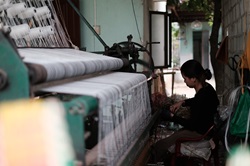Complete Weaving Mill Process

The weaving process is one of the most important processes in textile production. It is a complicated process and requires a lot of expertise to get it done right. The different parts of the process are warp sizing, warping, weaving, and taking up.
The weaving process is a complex process, and it can be confusing to understand all the steps of the process. With this guide, we will break down each step of the process so that you can better understand how weaving works.
The weaving process starts with yarns. Yarns are made up of two strands: one strand is called the warp and the other is called the weft. The warp is set up on a loom in order to create a pattern, while the weft is woven through it.
In order for there to be a pattern created by this method, there needs to be two sets of yarns: one set called “warp” and another set called “weft.”
Warping section or department in a weaving mill
The term “warp” derives from its first use as a verb meaning “to weave”. Warp threads are longitudinal threads that run parallel to each other and are stretched in one direction across a loom. A weaver who prepares the warp is called a warper; one who prepares it after it comes from the mill is sometimes called an overseer or dresser. Warping is a process of preparing the loom to weave. It is the process of winding yarn or thread onto a long, narrow, continuous piece of wood called a warp beam. The yarns are held taut and parallel to each other. Once the warp has been wound on the beam, it can be secured in place with ties or clips.
Complete Weaving Mill Process
Sizing in a weaving mill or fabric manufacturing
Sizing is a process conducted after the warping function. Here the yarn lapped on beam is coated with some material which increases in strength of yarn so that it may run smoothly during the next step of fabric manufacturing.
Weaving Section
Here starts the final stage of Raw Fabric manufacturing. The Machines used in this process are called looms. There are several types of looms being used to produce fabric. We will introduce you to some mainly used weaving machines or looms in this article.
Auto Loom or how an Auto Loom works
- The auto loom function was invented by Charles Weldon in 1814. It was an improvement on a previous invention called the flying shuttle, which required a person to move it back and forth manually. The machine consists of two sets of threads, one set for each warp, that are stretched over and through a series of heddles and then attached to a shuttle that moves back and forth across the width of the fabric. The shuttle is controlled by cams on a rotating shaft with different patterns for each type of weave.
Shuttle Less Loom or how a Shuttle Less Loom works
A shuttle is a device that holds the weft yarn, which is threaded through the warp yarns. A shuttle less loom function is a type of loom that does not require a shuttle to carry weft yarn. The first loom was invented around 4000 BC and it consisted of two sticks with threads stretched between them. It was used for weaving cloth by hand. The process of weaving cloth on these looms was slow, tedious, and required much skill. The invention of the shuttle less loom function in 1738 significantly changed this process and made it much quicker and easier.
Air Jet Loom or how an Air Jet Loom works
The air jet loom is a type of loom that is more advanced than the conventional loom. It is used for weaving fabrics that are usually made from synthetic fibers. The air jet loom functions by blowing compressed air through a nozzle to create loops of yarn on the surface of the fabric. This process is known as looping and it resembles sewing in many ways. It creates loops by pressing the needle against the fabric’s surface and then releasing it to pull up a loop of yarn before repeating this process.
Air jet looms are used to weave fabric. They use air jets instead of typical brushes or rollers. Air jet looms are also faster than most other looms, allowing production times to be much shorter.
Water Jet Loom or How a water Jet Loom works
Air jet looms are used to weave fabric. They use air jets instead of typical brushes or rollers. Air jet looms are also faster than most other looms, allowing production times to be much shorter.
The water jet loom is a unique tool in the world of weaving. It uses the power of high-pressure water to create an intricate and diverse range of designs. Fabric woven on an air jet loom is stronger, more flexible and has better textural properties than traditional weaving.
Rapier Loom or How a Rapier Loom works
Rapier looms are a type of power loom and they can be used to weave products such as tablecloths, rugs, and clothing. An ideal laptop for craft weaving is the HP w19i rapier loom. It offers maneuverability, flexibility and a sturdy design to ensure optimal performance while weaving on the go. Power looms use a series of wires that power your material through the weaving process; shuttle looms utilize this same concept but use shuttles that slide across the fabric rather than a series of wires.
Rapier loom is a special type of power loom, with a slanted blade. It was used to propel the shuttle through between two sets of heddles, or to make the textile threads stretch out over one row of wood batten and then onto another row of batten at the other end of the loom. The term “rapier-loom” (or “rapier”) acquired its name from these blades that were designed so that the threads would be caught, or perhaps not caught at all, by these lower blades and then propelled into the shedder called “heddle bar”.
The rapier loom is a hand-woven textile that uses a shuttle to weave individual threads. The rapier loom is most commonly used in the making of rugs, but it can also be used to make decorative fabrics, wall coverings and area carpets
